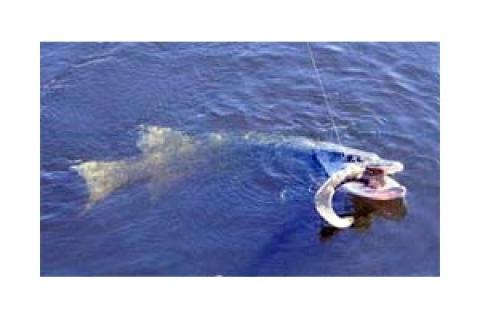
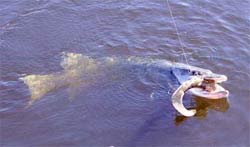 The mighty muskie conjures up a vision of immense size, razor sharp teeth, and acrobatic jumps. Perched at the top of the freshwater food chain, the Esox masquinongy is an ornery and fierce competitor, giving the angler spectacular thrills and chills with each and every battle. But does it really take 10,000 casts to catch one of these "fabled" fish? Not in the least bit, especially if you equip yourself with the proper fishing lures and baits in order to get the job done right. Read on to discover what a muskie truly loves to eat — artificially speaking that is.
The mighty muskie conjures up a vision of immense size, razor sharp teeth, and acrobatic jumps. Perched at the top of the freshwater food chain, the Esox masquinongy is an ornery and fierce competitor, giving the angler spectacular thrills and chills with each and every battle. But does it really take 10,000 casts to catch one of these "fabled" fish? Not in the least bit, especially if you equip yourself with the proper fishing lures and baits in order to get the job done right. Read on to discover what a muskie truly loves to eat — artificially speaking that is.
Bucktail Lures
Bucktail fishing lures are the bread-and-butter of the muskie world — this is a lure that can be fished in a variety of ways, has a great hooking percentage and is easy to toss and retrieve all day long. And one other thing — they sure do catch fish!
A bucktail is basically an inline spinner bait (large revolving blade at the top) that has a body constructed of animal hair built on a wire shaft. Deer hair is predominantly used to manufacture these baits, hence the insightful name.
Bucktails come in every size and color imaginable, as do the flashy blades that adorn the lure.
 |
| Bucktails are great baits for covering water and finding fish. |
For starters, I would suggest picking up two or three bucktail baits, choosing some small and some larger ones for experimentation and variety.For the most part, early in the season calls for downsized presentations (5-inch), with larger baits (7 inches and up) taking over as the water warms and the season progresses.The larger the bucktail, the greater the silhouette will be when traveling through the water. Again, I like to keep my fishing lures more compact earlier in the season, and bulk-up as the days grow longer.
Colors can be a hot topic whenever muskie anglers are concerned, although having some natural and brighter hues on board is the best approach to take. Brown, black, and white are productive "mother-nature" schemes, while yellow, purple, and blaze orange all have their place and time. A key concept to store under the hat is the use of darker colors during dark days and brighter shades when the sun is shining.
Choosing the right spinner blade can also be crucial to the package. For the most part, producing a bright flash and audible sound is the ticket to more muskie, so large Colorado blades in silver, gold or orange finishes, are strongly suggested. The key is to experiment, especially under different weather conditions and water clarities.
Bucktails are great baits for covering water and finding fish — a crucial tactic that will help in whittling down the casts from 10,000.
Jerkbaits
This style of crankbait garners its name directly from the action that the angler imparts. The resulting "jerks" that are transmitted down the line through the manipulation of the rod, forces the lure to swim and dive in a fashion that can literally drive muskies mad with anger.
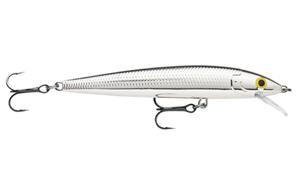 |
| For many anglers, jerkbaits are all they throw during the fall. |
Jerkbaits are made of wood or plastic, and will usually have a small or non-existent lip, depending on the style of lure. Most jerkbaits will dive anywhere between a foot and 10 feet deep, allowing the intuitive angler the opportunity to cover a wide variety of water.
Although many of the jerkbaits currently on the market vary in size and shape, the most important triggering effect seems to be the action they take on when they get wet. Long pauses, fast rises or an uncontrolled swimming pattern all have their time and place. It is for this reason alone that I suggest picking up two or three different styles of jerkbaits purely for the experimentation factor.
Jerkbaits really shine as the days grow shorter and the leaves begin to fall. With the advent of dropping water temperatures, the slow and deliberate cadence of a well-presented jerkbait takes on a life of its own. For many anglers, jerkbaits are all they throw come fall time, and let me tell you, they certainly are on to something.
When choosing a jerkbait for the first time, ensure that the bait has been constructed in a solid manner, that the hooks are large and razor sharp and that the lip is sturdy and rigid. I throw jerks that range in size from five-inches all the way up to twelve, relying on larger lures when the summer season bids its farewell. When it comes to color, matching the forage base is a step in the right direction. Lures that have been painted to resemble the natural look of a walleye, perch, smallmouth, or ciscoe are great choices when it comes to stocking the tackle box.
Topwater Fishing Bait
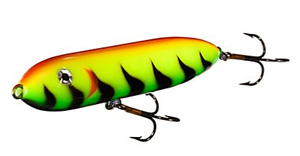 |
|
Another popular variety of topwater bait is the cigar style or "walk-the-dog" type. |
When it comes to heart-stopping thrills and chills, nothing can compare to the results that a topwater muskie bait can bring. For those that have never witnessed a 20-pound fish annihilate a surface lure on a calm summer evening — you're certainly in for a big surprise. (I must warn you — some of these attacks are not for the weak of heart!)
As with most of the groups of muskie lures, topwaters come in a wide variety of styles and actions. One of the most popular (and most deadly) on the market is the "prop" style bait. This type of lure consists of large props or rotating body parts that churn up the water upon retrieve. The surface commotion they create, as well as the audible sounds, are ideal for luring in muskie and convincing them to bite. Stock up your box with a prop bait that is 6-8 inches in length, has strong, sturdy props and large hooks that will help in sticking that fish.
Another popular variety of topwater bait is the cigar style or "walk-the-dog" type. This surface bait has no action of its own, relying completely on the angler to impart the necessary rod movements to make it work effectively. They take a bit of practice to perfect, but once you do, they can bring astonishing results. My advice is to start off with a lure that is six or seven-inches long, as well as putting in your time on the water to learn the intricacies and tactics that will eventually produce.
Crankbaits
Duplicating the action and visual aspect of their desired prey, crankbaits are a perfect choice to toss when searching for Mr. Muskie.
Similar in all aspects to the common bass or walleye crank, (other than the "steroid" enhanced size and length), muskie crankbaits create a large profile and tantalizing swimming action that can fool even the most cunning of fish.
 |
| With murky water conditions, a brightly colored fish bait will get more attention. |
Crankbaits can be utilized in two distinct manners — trolling or casting.Both techniques produce results, with trolling allowing the angler to cover water and casting enabling precise working-over of cover and structure.
Many of the crankbaits that line the tackle shelves can be used to cover both applications, thereby simplifying the selection process when it comes time to buy. For those starting out, picking up three separate baits that can used for shallow, medium, and deep depths would be ideal.
Similar to regular cranks, the size and angle of the lip will dictate how far down a bait will go. Covering all of these bases, or should I say depths, will help you locate where the muskie is lurking and will allow you to lure him into biting.
As with most of the lures styles I have discussed, color is a bit of a gray zone. Since you are literally "matching the hatch" when tossing cranks, natural colors do make the most sense. However, during murky water conditions, a brightly colored bait will certainly garner more attention. Choose a few assorted shades of colors and see which works best on your home waters.
Spinnerbaits
We all know how effective spinnerbaits can be to a bass angler. Those searching for muskie, with a change to a super-size bait being the only prerequisite, can duplicate these same results to a "T."
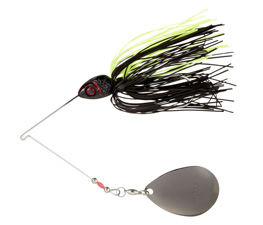 |
| For muskie night fishing, try a black-skirted spinnerbait with Colorado blades. |
Spinnerbaits work well because they are virtually weedless, can be worked quickly and have a high hooking percentage.They create a large silhouette when coming through the water, while producing a great deal of flash and vibration due to the rotating blades.This can spell magic when put into the hands of a muskie man.
When perusing the tackle store shelves, look for BIG baits that are designed specifically for muskie or pike. A common theme you will begin to notice is large, flashy blades, pumped up skirts and oversized hooks. Colorado blades will provide the most vibration and sound when being retrieved, whereas Willow Leaf blades will give you optimum flash. Good insight to know when you get out on the lake.
For those that want to try their hand at night fishing, spinnerbaits are a great tool for tossing. My personal favorite is a black-skirted model with beefed-up Colorado blades. This literally spells muskie in my books!
Daytime fishing will usually find me throwing spinnerbaits with lighter-shaded skirts, changing from metal or colored blades depending on the condition I'm faced with. Try to put at least two spinnerbaits of varying colors and sizes in your box, as this will enable you to effectively fish during most conditions, and will allow a change-up if things begin to slow down.
Muskie fishing doesn't have to be a tough game to play. With the right tool on the end of the line, your success rate is certain to rise. As with anything in the angling world, muskie fishing is a game of adaptation, tinkering and time spent on the water. By using the lures that I've discussed here, you'll quickly realize that 10,000 casts is nothing but an old wives tale, passed on from generation to generation. (Thank goodness for that, because my casting arm for certain can't handle that kind of abuse!!) Have fun stocking the tackle box and good luck on the water.
- 4968 views

